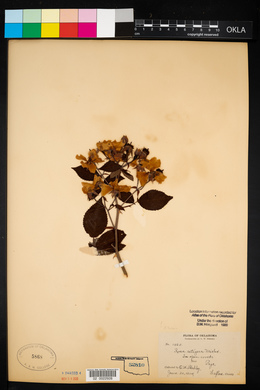Rosa setigera
|
|
|
|
Family: Rosaceae
Climbing Rose
[Rosa rubifolia R. Br., moreRosa setigera var. glabra Torr. & A. Gray] |
Shrub 2 - 5 m tall Stem: climbing to trailing, hairless, usually with sparse prickles that are stout, recurved, and flattened at the base. Leaves: pinnately compound, with a stalked-glandular and sometimes sparsely prickly stalk and three or five leaflets. The leaflets are glossy dark green and hairless above, paler and hairless to slightly hairy on veins beneath, 3- 10 cm long, lance-shaped to oblong-egg-shaped with an abruptly pointed tip, firm, and sharply toothed. Flowers: either male or female, found on separate plants (dioecious), borne several in a nearly flat-topped cluster (corymb), 4 - 8 cm across, with a glandular-hairy stalk and floral tube (hypanthium), non-persistent reflexed and glandular-hairy sepals 1.2 - 1.6 cm long, usually pink fading to whitish petals 2 - 3 cm long, and stamens and styles (hairless and united) that are exserted about the same length. Fruit: bony achenes surrounded by the mature floral tube (hip). The hip is red, 8 - 12 mm long, and nearly spherical. Stipules: subtending leaves, very narrow with a lance-shaped tip, non-toothed and sometimes glandular-hairy along margin. Similar species: Both Rosa multiflora and Rosa setigera have a climbing or trailing habit and flowers with united, protruding styles. Rosa multiflora differs by its seven or nine leaflets and its white flowers. Rosa setigera var. tomentosa is distinguished from the typical variety by its dull leaflets with hairy undersides. Flowering: late June to late July Habitat and ecology: Locally frequent in woodland clearings and along edges of woods. Occurence in the Chicago region: native Etymology: Rosa is the Latin name for a rose. Setigera means bristle-bearing. Author: The Morton Arboretum Stems climbing 2-4 m, glabrous, sparsely armed with stout, decurved, basally flattened prickles, or occasionally unarmed; stipules very narrow, glandular-ciliate, the free tip lanceolate, spreading; petioles stipitate-glandular, sometimes sparsely prickly; lfls 3 or 5, firm, glossy dark green, glabrous and impressed-veiny above, paler and glabrous to subtomentose beneath, lanceolate to oblong- ovate, 3-10 cm, the lateral subsessile, the terminal long-stalked; pedicels, hypanthium, and sep stipitate- glandular; dioecious; fls numerous; sep soon reflexed, deciduous; pet usually pink, 2-3 cm; styles connate, protruding from the hypanthium; hips small, brown-green; 2n=14. Thickets and fence-rows; sw. Ont. and O. to Io. and Kans., s. to w. N.C., Ga., La., and Tex. (R. rubifolia) Gleason, Henry A. & Cronquist, Arthur J. 1991. Manual of vascular plants of northeastern United States and adjacent Canada. lxxv + 910 pp. ©The New York Botanical Garden. All rights reserved. Used by permission. From Flora of Indiana (1940) by Charles C. Deam This species is distinguished from its variety [var. tomentosa] by having the lower surface of the leaflets glabrous or only the veins pubescent and the upper surface shining. It is not as common as the variety and does not extend as far north, becoming very rare in the northern counties. I do not find where the range of this species has been determined so I am forced to give the range as found in our manuals. [Variety tomentosa] is distinguished from the [full] species [R. setigera] by having the entire lower surface of the leaflets soft-pubescent and the upper surface dull. It is more frequent than the species and in some clearings it is often so abundant as to give them the appearance of rose gardens. The species and variety are found in open woodland, clearings, and pastures and along fences and roadsides. …… Indiana Coefficient of Conservatism: C = 4 Wetland Indicator Status: FACU |
|
|
|



































































